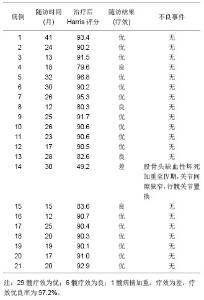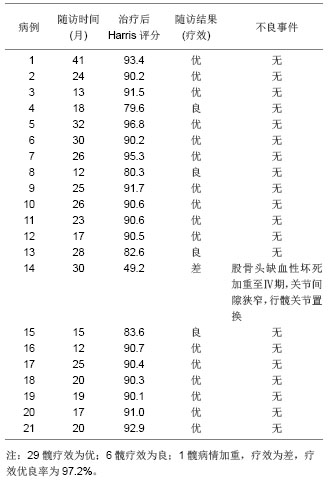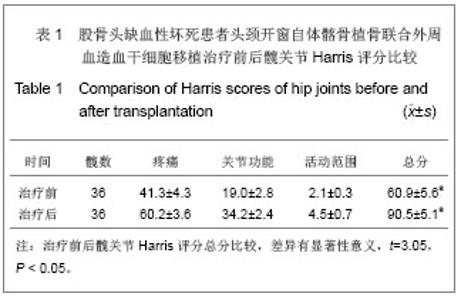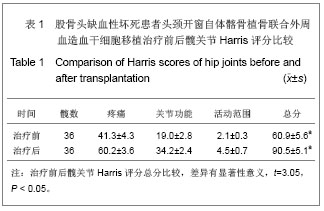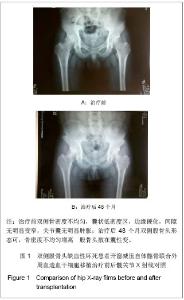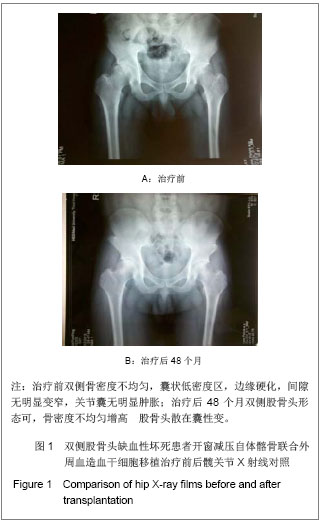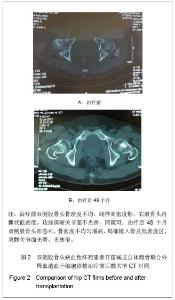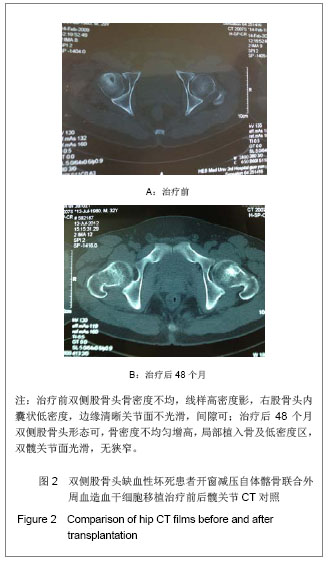| [1]Li ZY. Zhonghua Waike Zazhi. 1996; 34(3):186. 李子荣.股骨头坏死ARCO分期[J].中华外科杂志,1996, 34(3):186. [2]Zhonghua Yixuehui Guke Fenhui Xianwei Xiufuxuezu, Zhongguo Xiufu Chongjian Waike Zhuanye Weiyuanhui Guquesun ji Guhuaisixuezu. Zhongguo Guyuguanjie Waike. 2012;5(2):185-192.中华医学会骨科分会显微修复学组,中国修复重建外科专业委员会骨缺损及骨坏死学组.成人股骨头坏死诊疗标准专家共识(2012年版)[J].中国骨与关节外科,2012,5(2):185-192.[3]Harris WH. Traumatic arthritis of the hip after dislocation and acetabular fractures: Treatment by mold arthroplasty. An end result study using a new method of result evaluation. J Bone Joint Surg(Am). 1969;51:737-755. [4]Hang BL,Yu NS.Xiandai Linchuang Yixue Shengwu Gongchengxue Zazhi. 2004;10(1):44-46.黄必留,余楠生.人工全髋关节置换术后Harris 评分[J].现代临床医学生物工程学杂志,2004,10(1):44-46.[5]Yang ZQ, Yu GR. Hubei Yiyao Xueyuan Xuebao. 2011; 30(4): 434.杨祖清,余国荣.骨髓间充质干细胞移植治疗股骨头坏死的研究进展[J].湖北医药学院学报, 2011,30(4):434.[6]Tong PJ,Jin HT,He BJ et al. Zhonghua Guke Zazhi. 2010; 30(6):600.童培建,金红婷,何帮剑,等.干细胞介入治疗股骨头缺血性坏死的实验研究[J].中华骨科杂志,2010, 30(6):600.[7]Rosenwasser MP, Garino JP, Kiernan HA, et al. Long term follow up of thorough debridement and cancellous cone grafting of the femoral head for avascular necrosis. Clin Orthop Relat Res.1994;(306):17-27. [8]Mont MA, Etienne G, Ragland PS. Outcome of non-vascularized bone grafting for osteonecrosis of the femoral head.Clin Orthop Relat Res. 2003;417:84-92.[9]Wang BL, Sun W, Shi ZC, et al. Treatment of nontraumatic osteonecrosis of the femoral head using bone impaction grafting through a femoral neck window. Int Orthop. 2010; 34(5):635-639.[10]Baksi DP, Pal AK, Baksi DD. Long-term results of decompression and muscle-pedicle bone grafting for osteonecrosis of the femoral head. Int Orthop. 2009; 33(1): 41-47.[11]Li P,Jin QH,Lu ZD, et al. Ningxia Yixue Zazhi. 2011;33(12): 1195-1196.李鹏,金群华,陆志东,等.打压植骨治疗早中期股骨头无菌性坏死37例临床分析[J].宁夏医学杂志, 2011, 33(12):1195-1196.[12]Eisenschenk A, Lautenbach M, Schwetlick G, et al. Treatment of femoral head necrosis with vascularized iliac crest transplants. Clin Orthop Relat Res. 2001;(386):100-105.[13]Zhao D, Wang B, Guo L, et al. Will a vascularized greater trochanter graft preserve the necrotic femoral head? Clin Orthop Relat Res. 2010;468(5):1316-1324.[14]Körbling M, Katz RL, Khanna A, et al. Hepatocytes and epithelial cells of donor origin in recipients of peripheral-blood stem cells. N Engl J Med. 2002;346(10):738-746.[15]Jiang Y, Jahagirdar BN, Reinhardt RL, et al. Pluripotency of mesenchymal stem cells derived from adult marrow. Nature. 2002;418(6893):41-49.[16]Noël D, Djouad F, Jorgense C. Regenerative medicine through mesenchymal stem cells for bone and cartilage repair. Curr Opin Investig Drugs. 2002;3(7):1000-1004.[17]Yang XF, Wu YX, Wang HM, et al. Autologous peripheral blood stem cells transplantation in treatment of 62 cases of lower extremity ischemic disorder.Zhonghua Nei Ke Za Zhi. 2005;44(2):95-98. [18]Jacobs SA, Roobrouck VD, Verfaillie CM, et al. Immunological characteristics of human mesenchymal stem cells and multipotent adult progenitor cells. Immunol Cell Biol. 2013;91(1): 32-39.[19]Tang PX. Zhongguo Shiyan Xueyexue Zazhi. 2003;11(1):1-6. 唐佩弦.我国造血干细胞基础研究的新进展兼论干细胞可塑性[J].中国实验血液学杂志,2003,11(1):1-6. [20]Jiang XH,Li ZT. Xiandai Yiyao Weisheng. 2004;20(4):248-249.姜晓华,李忠轶.CD34-造血干细胞的研究进展[J].现代医药卫生, 2004,20(4):248-249. [21]Ji WF,Tong PJ,Zheng WB, et al. Zhongguo Zhongxiyi Jihe Zazhi. 2004;24(11): 999-1002.季卫锋,童培建,郑文标,等.骨髓多能干细胞动脉灌注治疗股骨头坏死的实验研究[J].中国中西医结合杂志,2004,24(11): 999-1002.[22]Sun W,Li ZR,Shi ZC et al. Zhongguo Kangfu Lilun yu Shijian Zazhi. 2005;11(1):4-7.孙伟,李子荣,史振才,等.骨髓间充质干细胞对股骨头坏死缺损模型修复的组织学观察[J].中国康复理论与实践杂志, 2005,11(1):4-7.[23]Zhao SM, Wang M, Zhang JG, et al. Zhongguo Zuzhi Gongcheng Yanjiu yu Linchuang Kangfu. 2008;12(8): 1573-1576赵淑贤,王敏,张建国,等.外周血干细胞与组织工程骨复合移植过程中转化生长因子β在修复犬牙周骨缺损的表达[J].中国组织工程研究与临床康复, 2008,12(8):1573-1576. [24]Lee HS, Huang GT, Chiang H,et al. Multipotential mesenchymalstem cells from femoral bone marrow near the site of esteonecrosis. Stem Cells. 2003;21(2):190-199.[25]Carlo-Stella C,Gianni MA.Biology and clinical applications of marrow mesenchymal stem cells. Pathol Biol(Paris). 2005; 53(3):162-164. [26]Kassem M.Mesenchymal stem cells:biological characteristics and potential clinical applications. Cloning Stem Cells. 2004; 6(4):369-374.[27]Gangji V,Hauzeur JP,Mates C,et al. Treatment of osteonecresis of the femoral head with implantation of autologous bone-marrow cells: a pilot study. J Bone Joint Surg(Am). 2004;86(6):1153-1160. [28]Hernigou P, Beaujean F. Treatment of osteonecrosis with autologous bone marrow grafting. Clin Orthop Relat Res. 2002;(405):14-23.[29]Gu YQ,Zhang J,Qi LX, et al. Zhongguo Chongjian Xiufu Waike Zazhi. 2007;21(7):675-678.谷涌泉,张建,齐立行,等.自体骨髓干细胞和外周血干细胞移植治疗下肢缺血的对比研究[J].中国重建修复外科杂志, 2007,21(7): 675-678. [30]Xu J,Tian J, Xu CR, et al. Zhongguo Zuzhi Gongcheng Yanjiu yu Linchuang Kangfu. 2008;12(3):515-517.徐军,田军,许超蕊,等.应用髋关节镜髓芯减压并自体外周血干细胞移植治疗早期股骨头缺血性坏死38列[J].中国组织工程研究与临床康复,2008,12(3):515-517.[31]Yang XF, Wang HM, Xu YF, et al. Zhonghua Waike Zazhi. 2007;45(20):1428-1431.杨晓凤,王红梅,许忆峰,等.干细胞移植改善股骨头坏死缺血状态122例临床观察[J].中华外科杂志, 2007,45(20):1428-1431.[32]Zhao D, Cui D, Wang B, et al. Treatment of early stage osteonecrosis of the femoral head with autologous implantation of bone marrow-derived and cultured mesenchymal stem cells. Bone. 2012;50(1):325-330. [33] Fu XS,Jiang PF. Zhongguo Guyuguanjie Waike. 2012;5(2): 169-172.付新生,蒋攀峰. 髂骨瓣联合自体骨髓间充质干细胞移植治疗早期股骨头坏死[J].中国骨与关节外科, 2012,5(2):169-172.[34]Li ZH, Liao W, Cui XL, et al. Intravenous transplantation of allogeneic bone marrow mesenchymal stem cells and its directional migration to the necrotic femoral head. Int J Med Sci. 2011;8(1):74-83.[35]Liu ZJ,Xu H. Zhongguo Linchuang Kangfu. 2003;7(4):2072- 2073.刘志君,徐辉.干细胞的研究及应用前景[J].中国临床康复, 2003, 7(4):2072-2073.[36]Han ZC. Jichu Yixue yu Linchuang. 2003;23(S1):3-4.韩忠朝. 干细胞技术与组织器官修复再造[J].基础医学与临床, 2003,23(S1):3-4.[37]Zhang Q, Zhang W. Hebei Yiyao. 2007;35(3):257-258.张勤,张文.干细胞研究进展及其应用前景[J].河北医药,2007, 35(3):257-258.[38]Shi WH, Wang LZ, Song JD. Guowai Yixue: Yichuanxue Fence. 2002;25(2):94-96.时伟红,王禄增,宋今丹.干细胞的研究和临床应用[J].国外医学: 遗传学分册,2002,25(2):94-96. |
